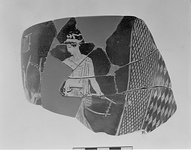Agora Object: Agora XXX, no. 1327 | Chronology: | | Ca. 430 B.C. | | Deposit: | | B 19 | | Published Number: | | AV 30.1327 | | References: | | Object: P 19390
|
Three non-joining fragments, a + b + e and c with rim and wall as well as start of handle, d of wall. Reserved line at top of rim. Some of the drawing abraded. P.H. a/b/e) 0.118; est. diam. at rim 0.17; max. dim. c) 0.048, d) 0.052. A. D. Trendall, Charites: Studien zur Altertumswissenschaft (Festschrift Ernst Langlotz), Bonn 1957, pl. 25, 3; LIMC II, 1984, p. 269, no. 690:c, s.v. Apollon; J. Oakley, Hesperia 57, 1988, p. 186, cat. no. 58, pl. 53; LIMC VI, 1992, p. 670, no no., s.v. Mousa, Mousai.
A, Apollo and Muse. Fragment a + b + e (illustrated) shows Apollo (wreathed head, shoulders, right arm, hands) sitting to right with his lyre, dressed in a chiton. Before him stands a Muse (right arm, most of legs missing) holding a lyre in her left hand. She wears a peplos and has a leaved fillet around her head. Above Apollo's head is an uncertain object (a small shrine[?]). Above his lyre:
On the right, crosshatching, then a lozenge pattern with dots. Fragment c gives more of the crosshatching, and fragment d, both patterns. White (flaked): cord of Apollo's plektron; inscription; vine and berries of wreath; strings of fillet.
For the ornamental pattern beneath the handles, see Oakley, Hesperia 57, 1988 [ pp. 165--191], p. 171, note 25 with bibliography; also K. Schauenburg, JdI 103, 1988 [ pp. 67--85], pp. 81--84. Crosshatching to either side of the handle recurs on a skyphos Type A by the Marlay Painter, St. Petersburg, St. 808 (ARV2 1278, 33): I do not know what pattern appears directly below the handle. Lozenge pattern at the handles may also occur on skyphoi of Type A. Some examples are: Chiusi C 1828 by the Painter of Brussels R 330: three vertical bands of lozenges separated by chevrons (ARV2 930, 99; Addenda 306); Oxford 1966.709, compared with the Marlay Painter (ARV2 1281, ---; Paralip. 473); three unattributed: Utica (Tunisia), no no.: lozenges framed by crosshatching; A, satyr and maenad; B, lost; Louvre S 4055: lozenges framed by crosshatching; A--B, two satyrs; Warsaw 142210 (CVA, Varsovie 3 [Pologne 6], pl. 48 [279]:5). I know the Utica and Louvre examples from Bothmer's photographs. For the lozenge pattern on a stemless cup, see 1348.
C. Clairmont ("Studies in Greek Mythology and Vase Painting," Yale Classical Studies 15, 1957 [ pp. 161--178], p. 165, note 6) thinks that 1327 represents the contest between Apollo and Marsyas, for he did not accept Beazley's suggestion, made in the summer of 1953, that 1337, which shows a satyr, does not belong to 1327.
The Marlay Painter (ARV2 1278, 35).
|
